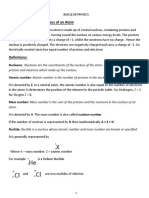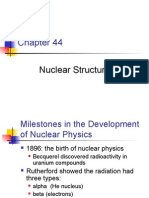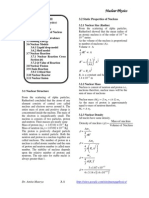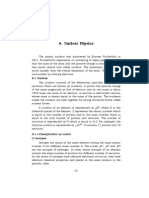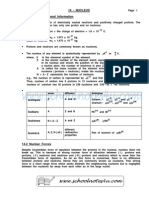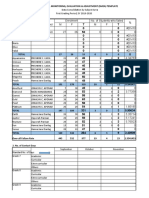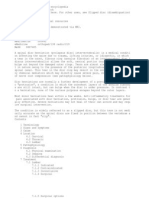Atoms and Nuclei
Atoms and Nuclei
Uploaded by
Bablu ChaudharyCopyright:
Available Formats
Atoms and Nuclei
Atoms and Nuclei
Uploaded by
Bablu ChaudharyOriginal Description:
Copyright
Available Formats
Share this document
Did you find this document useful?
Is this content inappropriate?
Copyright:
Available Formats
Atoms and Nuclei
Atoms and Nuclei
Uploaded by
Bablu ChaudharyCopyright:
Available Formats
One Stop for Colleges Education Career
Covers complete IITJEE/AIEEE syllabus Lessons, tests by IIT/NIT toppers Chemistry, Maths and Physics Sections 1000+ Questions and Sample tests Last minute preparation and help Its Free
Minglebox Engineering Prep
Free Online Preparation for Engineering with Minglebox Engineering Prep. Cover basic concepts of under Section for Engineering Entrance Exam Preparation with Study material, solved examples and tests prepared by IIT/NIT toppers.
Minglebox Engineering Prep
Minglebox.com
Atoms and Nuclei
Atom, as a whole, is electrically neutral and therefore contains equal amount of positive and negative charges. In Thomsons model, an atom is a spherical cloud of positive charges with electrons embedded in it. In Rutherfords model, most of the mass of the atom and all its positive charge are concentrated in a tiny nucleus (typically one by ten thousand the size of an atom), and the electrons revolve around it. Rutherford nuclear model has two main difficulties in explaining the structure of atom: (a) It predicts that atoms are unstable because the accelerated electrons revolving around the nucleus must spiral into the nucleus. This contradicts the stability of matter. (b) It cannot explain the characteristic line spectra of atoms of different elements.
Minglebox Engineering Prep
Minglebox.com
Atoms of each element are stable and emit characteristic spectrum. The spectrum consists of a set of isolated parallel lines termed as line spectrum. It provides useful information about the atomic structure.
The atomic hydrogen emits a line spectrum consisting of various series. The frequency of any line in a series can be expressed as a difference of two terms; o Lyman series: v = Rc{ (1/12) (1/n2)} ; n = 2,3,4.. o Balmer Series: v = Rc{ (1/22) (1/n2)} ; n = 3,4,5.. o Paschen Series: v = Rc{ (1/32) (1/n2)} ; n = 4,5,6.. o Brackett Series: v = Rc{ (1/42) (1/n2)} ; n = 5,6,7.. o Pfund Series: v = Rc{ (1/52) (1/n2)} ; n = 6,7,8.. To explain the line spectra emitted by atoms, as well as the stability of atoms, Niels Bohr proposed a model for hydro genic (single electron) atoms. He introduced three postulates and laid the foundations ofquantum mechanics:
Minglebox Engineering Prep
Minglebox.com
o In a hydrogen atom, an electron revolves in certain stable orbits(called stationary orbits) without the emission of radiant energy.
o The stationary orbits are those for which the angular momentum is some integral multiple of h/2. (Bohrs quantisation condition.) That is L = nh/2, where n is an integer called a quantum number.
o The third postulate states that an electron might make a transition from one of its specified nonradiating orbits to another of lower energy. When it does so, a photon is emitted having energy equal to the energy difference between the initial and final states. The frequency () of the emitted photon is then given by
h = Ei Ef
An atom absorbs radiation of the same frequency the atom emits, in which case the electron is transferred to an orbit with a higher value of n.
Minglebox Engineering Prep
Minglebox.com
Ei + h = Ef
As a result of the quantisation condition of angular momentum, theelectron orbits the nucleus at only specific radii. For a hydrogen atomit is given by rn = (n2/m)(h/2)2 (4 0/e2)
The total energy is also quantized as En = - (me4/8n2 02 h2) = - 13.6 eV/n2
The n = 1 state is called ground state. In hydrogen atom the ground state energy is 13.6 eV. Higher values of n correspond to excited states (n > 1). Atoms are excited to these higher states by collisions with other atoms or electrons or by absorption of a photon of right frequency.
Minglebox Engineering Prep
Minglebox.com
De Broglies hypothesis that electrons have a wavelength = h/mv gave an explanation for Bohrs quantised orbits by bringing in the wave particle duality. The orbits correspond to circular standing waves in which the circumference of the orbit equals a whole number of wavelengths. Bohrs model is applicable only to hydro genic (single electron) atoms. It cannot be extended to even two electron atoms such as helium. This model is also unable to explain for the relative intensities of the frequencies emitted even by hydro genic atoms.
Minglebox Engineering Prep
Minglebox.com
Nuclei
An atom has a nucleus. The nucleus is positively charged. The radiusof the nucleus is smaller than the radius of an atom by a factor of104. More than 99.9% mass of the atom is concentrated in the nucleus. On the atomic scale, mass is measured in atomic mass units (u). Bydefinition, 1 atomic mass unit (1u) is 1/12 thmass of one atom of 12C; 1u = 1.660563 1027 kg. A nucleus contains a neutral particle called neutron. Its mass is almostthe same as that of proton The atomic number Z is the number of protons in the atomic nucleusof an element. The mass number A is the total number of protons andneutrons in the atomic nucleus; A = Z+N; Here N denotes the numberof neutrons in the nucleus. A nuclear species or a nuclide is represented as AXZ, where X is thechemical symbol of the species.
Minglebox Engineering Prep
Minglebox.com
Nuclides with the same atomic number Z, but different neutron numberN are called isotopes. Nuclides with the same A are isobars and thosewith the same N are isotones. Most elements are mixtures of two or more isotopes. The atomic massof an element is a weighted average of the masses of its isotopes. Themasses are the relative abundances of the isotopes. A nucleus can be considered to be spherical in shape and assigned aradius. Electron scattering experiments allow determination of thenuclear radius; it is found that radii of nuclei fit the formula R = R0 A1/3 where R0 = a constant = 1.2 fm. This implies that the nuclear density is independent of A. It is of the order of 1017 kg/m3. Neutrons and protons are bound in a nucleus by the short-range strong nuclear force. The nuclear force does not distinguish between neutron and proton. The nuclear mass M is always less than the total mass, m, of its constituents. The difference in mass of a nucleus and its constituents is called the mass defect, M = (Z mp+ (A Z )mn) M
Minglebox Engineering Prep
Minglebox.com
Using Einsteins mass energy relation, we express this mass difference in terms of energy as Eb= M c2 The energy Ebrepresents the binding energy of the nucleus. In the mass number range A = 30 to 170, the binding energy per nucleon is nearly constant, about 8 MeV/nucleon. Energies associated with nuclear processes are about a million timeslarger than chemical process. The Q-value of a nuclear process is Q = final kinetic energy initial kinetic energy. Due to conservation of mass-energy, this is also, Q = (sum of initial masses sum of final masses)c2 Radioactivity is the phenomenon in which nuclei of a given speciestransform by giving out or or rays; -rays are helium nuclei; -rays are electrons. -rays are electromagnetic radiation of wavelengthsshorter than X-rays; Law of radioactive decay : N (t) = N(0) et where is the decay constant or disintegration constant.
Minglebox Engineering Prep
Minglebox.com
The half-life T1/2 of a radionuclide is the time in which N has beenreduced to one-half of its initial value. The mean life is the time atwhich N has been reduced to e1 of its initial value. T1/2= (ln 2/ ) = ln2 Energy is released when less tightly bound nuclei are transmuted intomore tightly bound nuclei. In fission, a heavy nucleus like 92 U235 breaksinto two smaller fragments. The fact that more neutrons are produced in fission than are consumedgives the possibility of a chain reaction with each neutron that isproduced triggering fission. The chain reaction is uncontrolledand rapid in a nuclear bomb explosion. It is controlled and steady ina nuclear reactor. In a reactor, the value of the neutron multiplicationfactor k is maintained at 1. In fusion, lighter nuclei combine to form a larger nucleus. Fusion ofhydrogen nuclei into helium nuclei is the source of energy of all starsincluding our sun.
10
Minglebox Engineering Prep
Minglebox.com
Sample Examples
11
Minglebox Engineering Prep
Minglebox.com
12
Minglebox Engineering Prep
Minglebox.com
You might also like
- Dissertation April 11Document138 pagesDissertation April 11dsjekw kjekwjeNo ratings yet
- 6th Sem Project ReportDocument93 pages6th Sem Project ReportSwati Kataria67% (3)
- 3 My Case StudyDocument6 pages3 My Case StudyAnimroslan AnimNo ratings yet
- Post Traumatic Stress DisorderDocument2 pagesPost Traumatic Stress Disorderapi-188978784100% (1)
- Shreyansh Physics RawDocument14 pagesShreyansh Physics RawdhruvlaltikarNo ratings yet
- (NIT Rourkela) Nuclear PhysicsDocument46 pages(NIT Rourkela) Nuclear PhysicsAditya JagadalaNo ratings yet
- Nuclear PHYSICSDocument195 pagesNuclear PHYSICSAugustte StravinskaiteNo ratings yet
- Nuclear Physics NotesDocument8 pagesNuclear Physics NotesCai Peng Fei100% (1)
- Krane NotesDocument14 pagesKrane NotesSubhasis PandaNo ratings yet
- 2024-12-01-0.5093190526922166Document10 pages2024-12-01-0.5093190526922166nikhilsaini180001No ratings yet
- Physics 08 NuclearDocument32 pagesPhysics 08 NuclearPiotr NowakNo ratings yet
- MathematicalDocument31 pagesMathematicalmohammed1998No ratings yet
- Lectures Subatom PropertiesDocument20 pagesLectures Subatom PropertiesrevathyrajanNo ratings yet
- Nuclear PhysicsDocument28 pagesNuclear PhysicsSatish Kumar100% (1)
- Module Nuc - Phys I (Phys382) New1Document26 pagesModule Nuc - Phys I (Phys382) New1davididosa40No ratings yet
- Chapter 3Document20 pagesChapter 3YasserMohammedNo ratings yet
- 3.091 - Introduction To Solid State Chemistry Lecture Notes No. 1 Atomic and Electronic StructureDocument21 pages3.091 - Introduction To Solid State Chemistry Lecture Notes No. 1 Atomic and Electronic Structuremukul kumarNo ratings yet
- 3rd Chapter (PHY-1203)Document48 pages3rd Chapter (PHY-1203)billmusa42No ratings yet
- Chapitre 1 1Document15 pagesChapitre 1 1Ri HabNo ratings yet
- 'NUCLEIDocument39 pages'NUCLEIRITIKANo ratings yet
- 1 - Extracted - Dhruv Physics (1) - MergedDocument17 pages1 - Extracted - Dhruv Physics (1) - MergeddhruvlaltikarNo ratings yet
- Nuclei: Atomic Mass Unit (U)Document10 pagesNuclei: Atomic Mass Unit (U)Jatin PanjwaniNo ratings yet
- Radiation PhysicsDocument26 pagesRadiation Physicsnirmalya prasun nayakNo ratings yet
- NUCLEAR PHYSICSDocument14 pagesNUCLEAR PHYSICSMd KalamNo ratings yet
- Shreyansh Physics FinalDocument17 pagesShreyansh Physics FinaldhruvlaltikarNo ratings yet
- Nuclear Physics PrimerDocument10 pagesNuclear Physics PrimerAnthony AffulNo ratings yet
- Chapter Four (Nuclear Power)Document121 pagesChapter Four (Nuclear Power)luter alexNo ratings yet
- PC Chapter 44Document85 pagesPC Chapter 44ultimuNo ratings yet
- Nuclear Physics 1Document7 pagesNuclear Physics 1dramita15No ratings yet
- Class 12 Physics Revision Notes AtomsDocument20 pagesClass 12 Physics Revision Notes Atomsashwin pranavNo ratings yet
- 3.091 - Introduction To Solid State Chemistry Lecture Notes No. 1 Atomic and Electronic StructureDocument21 pages3.091 - Introduction To Solid State Chemistry Lecture Notes No. 1 Atomic and Electronic StructuresakibNo ratings yet
- NUCLEUSDocument4 pagesNUCLEUSYug yadav lakhmaniNo ratings yet
- Lecture 1Document33 pagesLecture 1fatimaasiriNo ratings yet
- Nuclear StructureDocument37 pagesNuclear StructureNaresh KumarNo ratings yet
- 1 IntroductionDocument42 pages1 IntroductionJustine CabuayNo ratings yet
- L-13 - Nuclei NotesDocument12 pagesL-13 - Nuclei Notespramiti.gNo ratings yet
- AtomDocument28 pagesAtomCynthi Ramírez ValenzuelaNo ratings yet
- Nuclear Engineering NotesDocument36 pagesNuclear Engineering NotesMatthew CurmiNo ratings yet
- Nucleus Full Jee 2024Document46 pagesNucleus Full Jee 2024prakharsingh0606No ratings yet
- NUCLEI NOTESDocument8 pagesNUCLEI NOTESbangladesh9451No ratings yet
- Particle & Nuclear PhysicsDocument28 pagesParticle & Nuclear PhysicsSharda ShahNo ratings yet
- Chapter One Atomistic-1Document43 pagesChapter One Atomistic-1laraamuhieNo ratings yet
- Nuclear Physics Class x1 NoteDocument14 pagesNuclear Physics Class x1 Noteduttamrit629No ratings yet
- Nuclearchemistrybsci 170708171032Document42 pagesNuclearchemistrybsci 170708171032Victor OkosunNo ratings yet
- Radioactivity HSCDocument11 pagesRadioactivity HSCRushita LingiahNo ratings yet
- Nuclear PhysicsDocument20 pagesNuclear PhysicsShubh GuptaNo ratings yet
- Structure of AtomDocument6 pagesStructure of AtomAbhishekkpNo ratings yet
- CBI 1 - Fundamentals of ChemistryDocument10 pagesCBI 1 - Fundamentals of ChemistryRianna N100% (1)
- Nuclear Physics: 8.1 NucleusDocument48 pagesNuclear Physics: 8.1 NucleusJanani PillaiNo ratings yet
- PHS A DSE B1 TH Lecture 1Document12 pagesPHS A DSE B1 TH Lecture 1inzy283No ratings yet
- Nuclear Tutorial SolutionDocument19 pagesNuclear Tutorial SolutionGordon GohNo ratings yet
- Section:BOYS' &GIRLS' Date:7-04-20 Class & Div.:XI (All Divisions) Subject:CHEMISTRY Lesson / Topic: ATOMIC STRUCTURE - 1Document8 pagesSection:BOYS' &GIRLS' Date:7-04-20 Class & Div.:XI (All Divisions) Subject:CHEMISTRY Lesson / Topic: ATOMIC STRUCTURE - 1Mohammed IliasNo ratings yet
- Dasar-Dasar Radiofarmasi: Lecturer: Prof. Resmi Mustarichie MSC, PH.D, AptDocument25 pagesDasar-Dasar Radiofarmasi: Lecturer: Prof. Resmi Mustarichie MSC, PH.D, Aptkiki ikrimaNo ratings yet
- UNIT III Nuclear ChemistryDocument6 pagesUNIT III Nuclear ChemistrySivakumar PonnusamyNo ratings yet
- Nuclei NewDocument15 pagesNuclei NewB 06 Tenzin Stopden100% (1)
- Important Formula For Numerical:-: 4 Einstein S Mass Energy Equivalence Relation Is E MCDocument28 pagesImportant Formula For Numerical:-: 4 Einstein S Mass Energy Equivalence Relation Is E MCdhirendrasisodiaNo ratings yet
- Review 402Document50 pagesReview 402Serdar CharyyevNo ratings yet
- Nuclear Physics and Examples-2022Document14 pagesNuclear Physics and Examples-2022OSCARNo ratings yet
- 14 - Nucleus 14.1 Nucleus - General InformationDocument12 pages14 - Nucleus 14.1 Nucleus - General InformationHrishabh GuptaNo ratings yet
- Negative Mass and Negative Refractive Index in Atom Nuclei - Nuclear Wave Equation - Gravitational and Inertial Control: Part 2: Gravitational and Inertial Control, #2From EverandNegative Mass and Negative Refractive Index in Atom Nuclei - Nuclear Wave Equation - Gravitational and Inertial Control: Part 2: Gravitational and Inertial Control, #2No ratings yet
- Negative Mass and Negative Refractive Index in Atom Nuclei - Nuclear Wave Equation - Gravitational and Inertial Control: Part 3: Gravitational and Inertial Control, #3From EverandNegative Mass and Negative Refractive Index in Atom Nuclei - Nuclear Wave Equation - Gravitational and Inertial Control: Part 3: Gravitational and Inertial Control, #3No ratings yet
- Negative Mass and Negative Refractive Index in Atom Nuclei - Nuclear Wave Equation - Gravitational and Inertial Control: Part 4: Gravitational and Inertial Control, #4From EverandNegative Mass and Negative Refractive Index in Atom Nuclei - Nuclear Wave Equation - Gravitational and Inertial Control: Part 4: Gravitational and Inertial Control, #4No ratings yet
- Concepts of Nuclear Medicine Volume I: Concepts of Nuclear Medicine, #1From EverandConcepts of Nuclear Medicine Volume I: Concepts of Nuclear Medicine, #1No ratings yet
- Garcia vs. Comelec, GR 111230, September 30, 1994Document32 pagesGarcia vs. Comelec, GR 111230, September 30, 1994vj hernandezNo ratings yet
- Individual and Group BehaviourDocument72 pagesIndividual and Group BehaviourAyush SharmaNo ratings yet
- Urgent Legal Notice To Kotak - 30102021 - 211030 - 182306Document4 pagesUrgent Legal Notice To Kotak - 30102021 - 211030 - 182306spahujNo ratings yet
- Seci ModelDocument7 pagesSeci Modelmed11dzNo ratings yet
- Smea - MPS Fil ConsoDocument12 pagesSmea - MPS Fil ConsoJennyboy CasulNo ratings yet
- Argumentative Essay OutlineDocument2 pagesArgumentative Essay OutlineGamzeNo ratings yet
- Physics Standard Level Paper 3: Instructions To CandidatesDocument24 pagesPhysics Standard Level Paper 3: Instructions To CandidatesHADRIANNo ratings yet
- CPI AI Case Study Criminal JusticeDocument7 pagesCPI AI Case Study Criminal JusticeAnaliza V. MuñozNo ratings yet
- Year Zero Mini-v1.0.5-FREEDocument9 pagesYear Zero Mini-v1.0.5-FREEAlberto Roberto100% (2)
- A. Fill-In The KWL Chart With The Needed Information in The KWL ChartDocument13 pagesA. Fill-In The KWL Chart With The Needed Information in The KWL ChartBelle Herminigildo AngelesNo ratings yet
- 148) Reyes Vs TanDocument2 pages148) Reyes Vs TanChaNo ratings yet
- Choose The Right AnswerDocument12 pagesChoose The Right AnswercarmenbergsancNo ratings yet
- Tổng hợp đề thi HKI tiếng Anh lớp 11 (With key)Document42 pagesTổng hợp đề thi HKI tiếng Anh lớp 11 (With key)Nguyễn Ngọc HiểnNo ratings yet
- Unit 3 ContinuedDocument9 pagesUnit 3 Continuedsamuel debebeNo ratings yet
- Spinal Disc HerniationDocument5 pagesSpinal Disc HerniationJoshua Hong100% (1)
- Progress Test 2BDocument2 pagesProgress Test 2BZuzia MatyjaNo ratings yet
- Experiment No. 2: The Conical PendulumDocument7 pagesExperiment No. 2: The Conical PendulumHerbert James BandaNo ratings yet
- Don't Tell Peter - InstantKarmaGirlDocument8 pagesDon't Tell Peter - InstantKarmaGirlvictoria hernandez maquezNo ratings yet
- The Hero's Journey - Lord of The Rings: The Fellowship of The RingDocument1 pageThe Hero's Journey - Lord of The Rings: The Fellowship of The RingjanaNo ratings yet
- Adverbial Clauses: By: Khozainul Amin 4330017038Document13 pagesAdverbial Clauses: By: Khozainul Amin 4330017038Riise S PranataNo ratings yet
- Hardy AnthologyDocument47 pagesHardy Anthologysarahaliceparker100% (1)
- CBSE Class 7 Maths WorksheetDocument3 pagesCBSE Class 7 Maths WorksheetRamkrishna64% (11)
- Transportation Research Part F: EditorialDocument3 pagesTransportation Research Part F: EditorialAndreea FlorentinaNo ratings yet
- Trail of Tears Worksheet 1Document2 pagesTrail of Tears Worksheet 1api-292196043No ratings yet
- SonicWALL UTM Comparison and Sizing GuideDocument2 pagesSonicWALL UTM Comparison and Sizing GuideDolors AlmazánNo ratings yet
- Mobilizing Internal and External StakeholdersDocument15 pagesMobilizing Internal and External StakeholdersKATHERINE TOLENTINONo ratings yet

























